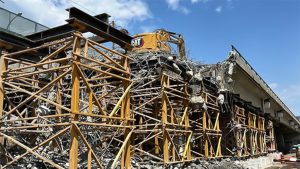Spring in Winnipeg means the end of winter, but also the start of the city’s pothole season.
On the bright side of the subject, a University of Manitoba engineer is researching an innovative way to repair damaged streets that not only saves money, but is also environmentally friendly.
Leonnie Kavanagh, a post-doctoral fellow in the university’s civil engineering department, is researching the use of recycled asphalt shingles (RAS) from landfills to make hot-mix asphalt that can be used to pave streets and fill potholes.
“I’ve been introducing three per cent recycled shingles into the standard mixture,” Kavanagh said.
The shingles are separated and put through a grinder, and the result looks like aggregate. The method has a number of benefits.
“There are cost savings of about five per cent for each tonne of mix containing three per cent recycled shingles,” said Kavanagh. “Since the price of hot-mix asphalt in Manitoba is about $750 per tonne, using RAS is commercially viable.”
Another benefit of RAS is sustainability.
“Using shingles reduces the use of virgin aggregate by the same amount,” Kavanagh said. “That saves money, and it is also environmentally friendly, because you don’t have to go out and dig up aggregate. And it reduces the amount of waste sent to landfills.”
Kavanagh has been using three per cent RAS asphalt at 15 different test sites around Winnipeg.
“It has performed the same as standard hot-mix asphalt,” she said.
Kavanagh is also looking at how the mix performs when the shingle content is increased to four per cent and five per cent.
The timing of Kavanagh’s research is particularly apt. The main cause of damaged streets is winter weather, and the 2013-14 winter was Winnipeg’s worst in 118 years.
“There were 36 nights when the low temperature was at least minus 30 C,” said Jim Berezowsky, manager of streets maintenance for the City of Winnipeg, which is collaborating with Kavanagh on the RAS project
In addition to being cold, the winter was unusually long. Berezowsky says there were no melting cycles after November 2013.
“That was very unusual,” he said. “During most winters, Winnipeg gets at least a couple of periods of relief from the low temperatures.”
The unusually harsh winter conditions were murder on the city’s roads.
“This year there have been 16 per cent more customer complaints than in 2013, which was also a tough winter, and 25 per cent more than the 10-year average,” Berezowsky said.
The city employs three different types of roadways: asphalt; chip-sealed (liquid asphalt and stone) in some areas on the edge of the city; and concrete with an asphalt surface.
In January every winter, the city starts filling potholes on asphalt and concrete-asphalt roads. In an average winter it will apply a total of about 1,000 tonnes of cold-mix repair asphalt. Each pothole requires an average of 60 kilograms of filler.
“The filler is mixed hot and allowed to cool and then it’s applied by hand,” Berezowsky said. “We use it because it is pliable in cold temperatures.”
The mix the City has been using is ProPatch, which it buys from Ontario-based Innovative Surface Solutions.
“We’ve been using ProPatch for three consecutive years,” Berezowsky. “It has performed well this spring.”
Despite the fact that most parts of Manitoba outside Winnipeg suffer even worse winters than the capital, the province’s 19,000 kilometres of provincial roads and provincial trunk highways manage to get through most winters in better shape.
“Some rural roads, especially in the southwest part of the province, have more potholes this year than usual, but this winter was not especially bad for most of them,” said Mike Knight, director of operational services of Manitoba Infrastructure and Transportation.
“Most of our roads don’t get as much traffic as the streets in Winnipeg.”
To repair provincial roads, the Ministry uses what it calls a winter mix.
“It’s not your typical asphalt,” Knight said. “We can use it in temperatures as low as minus 20 C”
The Ministry brings in 250 cubic metres to each of its 65 maintenance yards around the province in the fall of each year.
“It’s intended as a temporary fix that might last one summer,” Knight said. “We usually do a temporary fill, then wait until the ground thaws out and do a proper fill using regular hot-mix asphalt.”










Recent Comments
comments for this post are closed